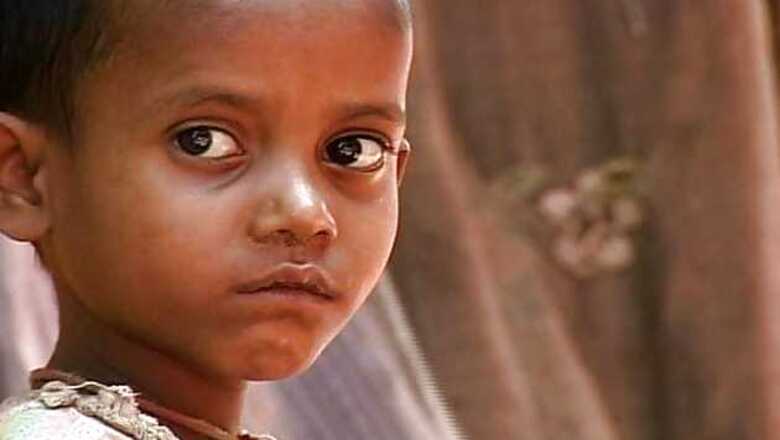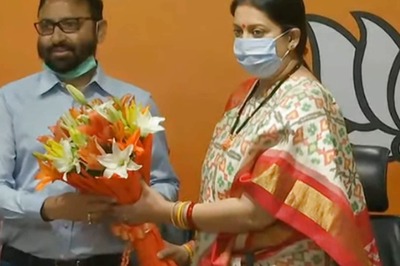
views
Dr Manoj Kumar Das is presently functioning as Director Projects at The INCLEN Trust International. Dr Das holds a MD degree in pediatrics from AIIMS, New Delhi. He has worked as a faculty at MAMC, Delhi for a brief tenure before taking public health research as full time career. He is leading several projects focusing on childhood pneumonia, diarrhea and vaccines at present funded by national and international agencies. His interest lies in the areas of child and maternal health, nutrition, health research capacity building, research priority setting and health technology application. He also hold the honorary position of Secretary, Research in Child Health Group of Indian Academy of Pediatrics.
1. Why is India home to the largest number of under-five child deaths in the world? What are the biggest killers for children?
A number of interlinked elements including poverty, malnutrition, mother's health, and access to medical care, in addition to the child's health conditions, lead to the persisting significant rates of under-five mortality and infant mortality. Apart from the health service coverage and quality related issues, several non-health and social factors also influence the health and mortality of the children.
The range of rates of under-five and infant mortality rates vary across the states and districts of India. While Kerala figures are comparable to developed countries, Assam, Uttar Pradesh, and Madhya Pradesh mortality rates are comparable to some African countries. In India, about half of the children who die, do so in the newborn period (first month of life). Beyond the neonatal period, pneumonia (25%) and diarrhoeal diseases (23%) are the leading causes of death in children 1-59 months of age. Apart from these, measles, other infections, and injury are the leading causes of death.
2. Pneumonia and diarrhoea are both preventable diseases. While the government has in place government programmes providing treatment services, do you think the government focuses sufficiently on preventive measures?
During the Call to Action Summit in 2013, the Government of India committed to support the efforts of reducing under-five mortality by launching, the RMNCHA+ strategy which encompasses reproductive, maternal, newborn, child, and adolescent health with health system strengthening and cross cutting interventions. This commitment has refined the focus on preventative efforts to save lives in India. Definite efforts towards reducing indoor air pollution and exposure to particulate materials are also yet to be in place- as a supplementary effort to prevent pneumonia. The rotavirus vaccine - which prevents the leading cause of moderate-to-severe diarrhoea -- has been announced for inclusion in the Universal Immunization Programme by the Prime Minister.
Vaccines are part of a comprehensive package of efforts that India should continue to use to combat child mortality, including: protect (e.g., breast feeding, adequate nutrition, hand washing, clean water and sanitation and reducing indoor air pollution), prevent (immunization), and treat (e.g., ORS plus zinc supplementation for treatment of diarrhea and oxygen and appropriate antibiotic therapy for pneumonia). Several of the key efforts for safe drinking water, safe food and waste disposal measures are outside health ministry domain. A lot of ground is still to be covered in these non-health sectors to reduce the burden of diarrhoea significantly. Malnutrition is an underlying cross cutting issue and its prevention lies primarily outside the health sector.
3. The government of India is has introduced a pentavalent vaccine against the Hib virus that is a leading cause of meningitis and pneumonia. It is planning on introducing a vaccine against rotavirus that causes diarrhea. Will you tell us more about these vaccines? What other vaccines are available for pneumonia and diarrhea?
The pentavalent vaccine is a combination vaccine which protects against five killer diseases -- diphtheria, pertussis, tetanus, hepatitis B, and Haemophilus influenzae type B. The pentavalent vaccine has replaced DPT vaccine in UIP (universal immunization programme) and is given at 6, 10, 14 weeks of age. This vaccine has reduced the number of injections to be given to the infants. It is currently rolled out in 16 states and with national plans underway.
Rotavirus is the leading cause (approximately 40%) of moderate-to-severe diarrhea in India. The government has taken a positive step in diarrhea prevention by announcing the inclusion of rotavirus vaccine in the routine immunization program.
The other vaccines available against pneumonia are: pneumococcal conjugate vaccine, influenza vaccine, and varicella vaccine. Vaccine against respiratory syncytial virus is also useful in reducing the risk of pneumonia.
4. India supplies more than half of all vaccines procured by international organizations, such as the World Health Organization (WHO) and the United Nations International Children's Emergency Fund (UNICEF). Still, approximately 35 per cent of Indian children are not vaccinated. Can you shed some light on this?
India is the largest manufacturer and supplier of vaccines globally. Unforunately at home, we still struggle with service delivery leaving more than one third of children unvaccinated or under vaccinated. Many challenges still need to be addressed to ensure demand-supply matching. There are need for local and district level innovations to increase vaccination coverage.
5. Mission Indradhanush is an initiative launched by the Ministry of Health and Family Welfare with the aim of increasing the reach of vaccines in saving the lives of Indian children. Do you think it will make any difference?
Mission Indradhanush is a very enthusiastic campaign to improve vaccine coverage in 201 high risk districts housing almost 50% of the partially immunized or un-immunized children. This campaign, supported by the partners, aims to increase vaccine coverage to at least 90% by reaching the missed and most vulnerable children. However sustaining coverage, will need a focus on overall strengthening of the immunization program and expanding reach to the underserved areas.
6.How do you think we can promote accountability of the government as well as health workers to ensure better health services reach our children?
The government (national and state) must try to ensure availability of infrastructure, manpower, and support services at each of the facilities as per the Indian Public Health Standards . Adequate financial allocation along with due delegation of powers for use shall facilitate service delivery. Engaging civil sector organisations and citizen charters along with the Government is essential to monitor and ensure accountability.
7. Many countries including our neighbouring Bangladesh have explored public-private partnerships to increase the reach of health services. Do you think the public and private sector can collaborate to provide better health services in India?
Public-private partnership (PPP) in health sector in India is not uncommon. Many efforts are ongoing throughout India, at different levels of facilities (PHC, CHC, tertiary care facilities), for different services (laboratory, imaging, diet), and different user charge models (user fee or free services). These partnerships could be leveraged to strengthen immunization and public health services to continue efforts to reduce under-five deaths. There could be further appropriate partnerships with vaccine manufacturers and other corporate organisation.
8. We have eradicated polio from our country through immunisation. Can India's successful polio legacy be replicated in other diseases like pneumonia and diarrhoea?
India's polio eradication effort is a real public health achievement and an example of a successful coordinated effort by all stakeholders. The focused approach, rigorous monitoring, and commitment from all levels made this possible. It is possible and most of the public health community is convinced that with strong political commitment coupled with appropriate strategy and financial commitment, the legacy of polio can be replicated for immunization, prevention of deaths due to pneumonia, diarrhoea, and malnutrition.



















Comments
0 comment